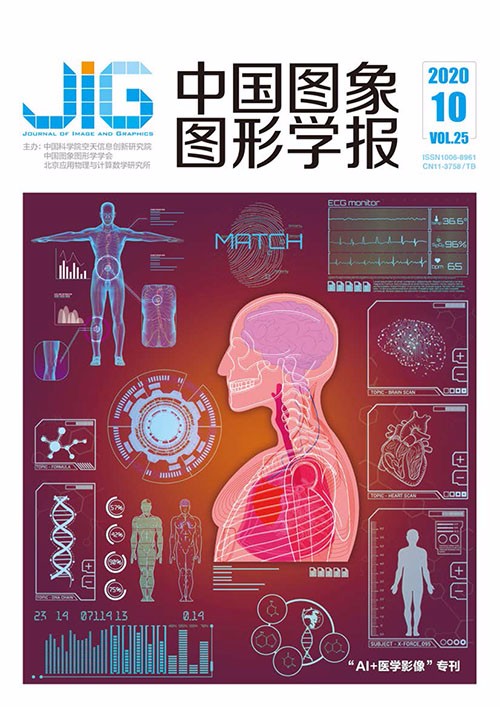
2D级联CNN模型的放疗危及器官自动分割
石军1, 赵敏帆1, 薛旭东2, 郝晓宇1, 金旭1, 安虹1, 张红雁2(1.中国科学技术大学计算机科学与技术学院, 合肥 230026;2.中国科学技术大学附属第一医院肿瘤放疗科, 合肥 230001) 摘 要
目的 精准的危及器官(organs at risk,OARs)勾画是肿瘤放射治疗过程中的关键步骤。依赖人工的勾画方式不仅耗费时力,且勾画精度容易受图像质量及医生主观经验等因素的影响。本文提出了一种2D级联卷积神经网络(convolutional neural network,CNN)模型,用于放疗危及器官的自动分割。方法 模型主要包含分类器和分割网络两部分。分类器以VGG(visual geometry group)16为骨干结构,通过减少卷积层以及加入全局池化极大地降低了参数量和计算复杂度;分割网络则是以U-Net为基础,用双线性插值代替反卷积对特征图进行上采样,并引入Dropout层来缓解过拟合问题。在预测阶段,先利用分类器从输入图像中筛选出包含指定器官的切片,然后使用分割网络对选定切片进行分割,最后使用移除小连通域等方法对分割结果进一步优化。结果 本文所用数据集共包含89例宫颈癌患者的腹盆腔CT(computed tomography)图像,并以中国科学技术大学附属第一医院多位放射医师提供的手工勾画结果作为评估的金标准。在实验部分,本文提出的分类器在6种危及器官(左右股骨、左右股骨头、膀胱和直肠)上的平均分类精度、查准率、召回率和F1-Score分别为98.36%、96.64%、94.1%和95.34%。基于上述分类性能,本文分割方法在测试集上的平均Dice系数为92.94%。结论 与已有的CNN分割模型相比,本文方法获得了最佳的分割性能,先分类再分割的策略能够有效地避免标注稀疏问题并减少假阳性分割结果。此外,本文方法与专业放射医师在分割结果上具有良好的一致性,有助于在临床中实现更准确、快速的危及器官分割。
关键词
Automatic segmentation of organs at risk in radiotherapy using 2D cascade-CNN model
Shi Jun1, Zhao Minfan1, Xue Xudong2, Hao Xiaoyu1, Jin Xu1, An Hong1, Zhang Hongyan2(1.School of Computer Science and Technology, University of Science and Technology of China, Hefei 230026, China;2.Department of Radiation Oncology, The First Affiliated Hospital of USTC University of Science and Technology of China, Hefei 230001, China) Abstract
Objective Accurate delineation of organs at risk (OARs) is an essential step in the radiation therapy for cancers. However, this procedure is frequently time consuming and error prone because of the large anatomical variation across patients, different experience of observers, and poor soft-tissue contrast in computed tomography (CT) scans. A computer-aided analysis system for OAR auto-segmentation from CT images will reduce the burden of doctors and the subjective errors and improve the effect of radiotherapy. In the early years, atlas-based methods are extremely popular and widely used in anatomy segmentation. However, the performance of atlas-based segmentation methods can be easily affected by various factors, such as the quality of atlas and registration methods. Recently, profits from the rapid growth of computing power and the amount of available data, deep learning, especially deep convolutional neural networks (CNNs), has shown great potential in the field of image analysis. For most of the medical image segmentation tasks, the algorithms based on CNN outperform traditional methods. As a special fully CNN, U-Net adopts the design of encoder-decoder and fuses the high- and low-level features by skip connections to realize pixelwise segmentation. Given the outstanding performance of U-Net, numerous derivatives of the U-Net architecture have been gradually developed in various organ segmentation tasks. V-Net is proposed as an improvement scheme of U-Net to address the difficulties in processing 3D data. V-Net can fully utilize the 3D characteristics of images, although it is unsuitable for the 3D medical image datasets with few samples and the segmentation tasks of small organs. Therefore, a two-step 2D CNN model is proposed for the automatic and accurate segmentation of OARs in radiotherapy. Method In this study, we propose a novel cascade-CNN model that mainly includes a slice classifier and a 2D organ segmentation network. visual geometry group (VGG)16 is used as the backbone structure of the classifier and modified accordingly by considering the time overhead and the size of available data. To reduce the parameters and calculation complexity, three convolutional layers are removed, and an additional global max pooling layer is used as the bridging module between the feature extraction and the fully connected layer. The segmentation network is built upon the U-Net by replacing the deconvolutional layers with bilinear interpolation layers to perform the upsampling for features. The dropout layer and the data augmentation are utilized to avoid the overfitting problem. The classifier and the segmentation network for each organ are implemented in Keras and independently trained with the binary cross-entropy and dice losses, respectively. We use adaptive moment estimation to stabilize the gradient descent process during the training of the two models. In the inference stage, the slices containing the target organs are first selected by the classifier from the entire CT scans. These slices are then used as the input of the segmentation network to obtain the results, and some simple post-processing methods are applied to optimize the segmentation results. Result The dataset containing CT scans of 89 cases of cervical cancer patients and the manual segmentation results provided by multiple radiologists in The First Affiliated Hospital of University of Science and Technology of China (USTC) are used as the gold standard for evaluation. In the experimental part, the average classification accuracy, precision, recall, and F1-score of the classifier on the six organs (left femoral head, right femoral head, left femur, right femur, bladder, and rectum) are 98.36%, 96.64%, 94.1%, and 95.34%, respectively. On the basis of the performance of the above classifiers, the proposed method achieves high segmentation accuracy on the bladder, left femoral head, right femoral head, left femur, and right femur, with Dice coefficients of 94.16%, 93.69%, 95.09%, 96.14%, and 96.57%, respectively. Compared with the single U-Net and cascaded V-Net, the Dice coefficient increases by 4.1% to 6.6%. For the rectum, all methods perform poorly because of the irregular shape and low contrast. The proposed method achieves a Dice coefficient of 72.99% on the rectum, which is approximately 20% higher than other methods. The comparison experiments demonstrate that the classifiers can effectively improve the overall segmentation accuracy. Conclusion In this work, we propose a novel 2D cascade-CNN model, which is composed of a classifier and a segmentation network, for the automatic segmentation of OARs in radiation therapy. The experiments demonstrate that the proposed method effectively alleviates the labeling sparse problem and reduces the false positive segmentation results. For the organs that immensely vary in shape and size, the proposed method obtains a significant improvement in segmentation accuracy. In comparison with existing neural network methods, the proposed method achieves state-of-the-art results in the segmentation task of OARs for cervical cancer and a better consistency with that of experienced radiologists.
Keywords
segmentation of organs at risk convolutional neural network(CNN) cascade model radiation therapy cervical cancer
|



 中国图象图形学报 │ 京ICP备05080539号-4 │ 本系统由
中国图象图形学报 │ 京ICP备05080539号-4 │ 本系统由